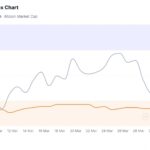The cryptocurrency market has recently experienced a whirlwind of activity, particularly in response to a range of economic developments. Following a significant announcement from President Donald Trump regarding new tariffs, traders are now shifting their focus toward upcoming economic data and potential interest rate cuts. This new landscape has sparked expectations of a possible bounce-back for Bitcoin in the near term.
“Investors are bracing for signs of softness in the U.S. labour market,”
High volatility characterized the crypto markets on Wednesday and Thursday as traders anticipated the tariff announcement. Trump’s decision to impose a minimum 10% fee on all imports led to immediate reactions, with major cryptocurrencies such as Bitcoin (BTC), Ethereum (ETH), Solana (SOL), and XRP witnessing rapid fluctuations. Initial gains evaporated as global markets reacted negatively, prompting a reassessment of positions across the board.
However, by Friday morning, there was a noticeable uptick in prices, with Bitcoin stabilizing above $83,100 and Ethereum reclaiming the $1,800 mark. Other altcoins like XRP and ADA saw gains of more than 2%. The days leading up to Trump’s remarks were marked by a significant increase in trading activity, with large volumes of BTC, ETH, and XRP being transferred to exchanges, a move indicating potential selling intent from investors. For example, a notable spike occurred in Bitcoin transactions, with as much as 2,500 BTC processed in a single block right after the president’s address.
“This reflected investor willingness to exit positions amid growing economic uncertainty,”
Content from CryptoQuant indicated that as markets fluctuated, demand for Bitcoin and ETH in the futures market diminished, prompting traders to take profits. Notably, Coinbase reported an increase in Bitcoin deposits from large holders, while Ethereum deposits soared to approximately 80,000 ETH within an hour. Similarly, XRP transactions surged dramatically on Binance, increasing to 130 million XRP in a single hour—the previous day’s average was under 10 million.
As traders continue to navigate through economic uncertainties, all eyes are now on the non-farm payroll report scheduled for release on Friday. This key economic indicator sheds light on employment changes, job creation, and wage growth, ultimately reflecting the overall economic health. Market sentiment hinges on the possibility of weaker-than-expected job figures, which could strengthen the case for further interest rate cuts from the Federal Reserve this year.
“Rate cuts occur when a central bank lowers interest rates to stimulate economic growth,”
Current market expectations are anticipating four rate cuts in 2025, fueling speculation about how these shifts could affect investment dynamics. Generally, rate cuts tend to benefit cryptocurrencies like Bitcoin, as lower borrowing costs can diminish the appeal of traditional investment avenues such as bonds, driving investors toward alternative assets. Furthermore, a weaker dollar might bolster Bitcoin’s value as individuals seek a hedge against inflation or currency devaluation.
Even amidst the uncertainty, analysts, including Singapore-based QCP Capital, are observing elevated volatility in the short term while noting that the markets are mostly oversold. The upcoming economic data could be the catalyst needed for a rebound, setting the stage for potential gains in the near future.

Market Reactions to Economic Changes and their Implications
The article highlights key developments in the cryptocurrency market amidst changes in U.S. trade policies and economic indicators. Here are the critical points to consider:
- Oversold Market Trends
- Current market sentiments indicate that traders are focusing on new economic data and anticipated rate cuts.
- Bitcoin (BTC) and other major cryptocurrencies are experiencing volatility, reflecting investor reactions to market conditions.
- Impact of U.S. Tariffs
- President Trump’s announcement of a minimum 10% tariff on imports influenced market behavior significantly.
- Crypto markets saw immediate reactions with major tokens experiencing a bounce followed by declines.
- Surge in Transactions and Market Activity
- Large volumes of Bitcoin and Ether being moved to exchanges suggest a potential sell-off among investors.
- Notable increases in ETH and XRP inflows indicate a trend of risk management amidst economic uncertainties.
- Upcoming Economic Data
- The non-farm payroll report is expected, which will provide insights into job creation and economic health.
- A weaker-than-expected jobs report might lead to further Federal Reserve rate cuts.
- Rate Cuts and Cryptocurrency Market Reactions
- Rate cuts typically lower borrowing costs, prompting investors to seek alternatives like cryptocurrencies.
- The Bitcoin market often responds positively to lower interest rates, enhancing its appeal as a hedge against inflation.
- Future Market Sentiments
- Market analysts are observing elevated volatility and positioning for potential near-term bounces in risk assets.
- Investment decisions may shift based on upcoming economic indicators and potential policy changes.
Understanding these market dynamics can help investors make informed decisions, potentially enhancing their financial security in uncertain economic times.
Crypto Market Reactions Amid Economic Shifts
The recent volatility in the cryptocurrency market has highlighted the intricate dance between governmental economic policies and digital asset reactions. With expectations of upcoming economic data, particularly around U.S. tariffs and Federal Reserve rate cuts, traders are adjusting their strategies. The announcement of a minimum 10% import fee by President Trump served as a catalyst for swift market movements, showcasing how sensitive crypto assets are to external economic indicators.
Competitive Advantages: One significant advantage is the growing interest from institutional players, such as Coinbase, which reported a surge in bitcoin deposits. This influx not only signifies confidence among large holders but also indicates that platforms are becoming robust channels for trading amid uncertainty. Moreover, discussions around potential rate cuts have historically been a boon for crypto, as lower interest rates can drive investors from traditional assets like bonds towards alternatives like Bitcoin, enhancing its appeal as a hedge against inflation.
Disadvantages: However, the downsides are equally notable. The immediate reaction to tariffs caused a sharp decline in major tokens—Bitcoin retraced its gains, and this pattern of volatility can alienate less experienced investors. The observed increase in trade volumes before the president’s announcement signals a trend where traders are becoming increasingly risk-averse, opting to exit positions rather than hold through uncertainty. This behavior, driven by fears of a declining economy, can lead to a tumultuous trading atmosphere, creating stress among crypto investors.
For traders, this dynamic presents both opportunities and challenges. Those prepared to navigate bouts of volatility could capitalize on potential rebounds, especially if the upcoming employment data suggests a softer labor market, prompting rate cuts. However, those without a solid risk management strategy may face significant losses, especially if they misjudge the volatility swings associated with these economic announcements.
Furthermore, investor activity—particularly the marked increase in deposit volumes directly before critical announcements—suggests that many are positioned to react quickly to unfavorable news, which could exacerbate price swings as rapid sell-offs occur. This behavior may ultimately create a more challenging environment for new entrants who may lack the experience to weather such storms.

















